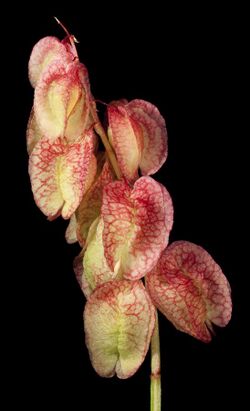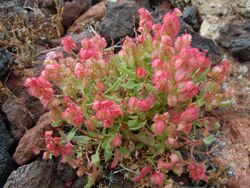Biology:Rumex vesicarius
| Rumex vesicarius | |
|---|---|

| |

| |
| Cultivar | |
| Scientific classification | |
| Kingdom: | Plantae |
| Clade: | Tracheophytes |
| Clade: | Angiosperms |
| Clade: | Eudicots |
| Order: | Caryophyllales |
| Family: | Polygonaceae |
| Genus: | Rumex |
| Species: | R. vesicarius
|
| Binomial name | |
| Rumex vesicarius | |
| Synonyms[3] | |
Rumex vesicarius, also known as Ruby dock,[4] or bladder dock,[3] is a species of perennial flowering plant in the family Polygonaceae.[3] According to Plants of the World Online, Rumex vesicarius is native to tropical and temperate Asia, Africa, and Western Australia.[3] However, the Council of Heads of Australasian Herbaria asserts that within Australia it is naturalised in Western Australia, the Northern Territory, South Australia, Queensland and New South Wales.[5]
Description
It is an erect, succulent annual herb which grows to up about 60 cm high, and has triangular to ovate leaves which are truncate or cordate at the base and about 5–10 cm long,[6] with entire margins.[7] The stipules form an almost complete sheath around the stem which disintegrates. The flowers are green with a red tinge, and have six perianth segments with the inner three becoming enlarged and papery when fruiting. The hard, red and reticulately veined fruit persist,[7] giving rise to spectacular displays.[6]
Etymology
The specific epithet, vesicarius, derives from the Latin word, vesica, meaning "bladder", to give an adjective which describes the fruit of the plant as "inflated", "bladder-like".[8]
References
- ↑ "Rumex vesicarius". Australian Plant Name Index (APNI), IBIS database. Centre for Plant Biodiversity Research, Australian Government. https://biodiversity.org.au/nsl/services/rest/name/apni/104863.
- ↑ Linnaeus, C. (1753) Species Plantarum 1: 336
- ↑ 3.0 3.1 3.2 3.3 "Rumex vesicarius L. | Plants of the World Online | Kew Science". http://powo.science.kew.org/taxon/urn:lsid:ipni.org:names:697616-1.
- ↑ Western Australian Herbarium, Biodiversity and Conservation Science. "Rumex vesicarius: FloraBase—the Western Australian Flora" (in en). https://florabase.dpaw.wa.gov.au/browse/profile/2443.
- ↑ "Rumex vesicarius". https://biodiversity.org.au/nsl/services/search?product=APNI&tree.id=&name=Rumex+vesicarius+L.&inc._scientific=&inc.scientific=on&inc._cultivar=&inc._other=&max=100&display=apni&search=true.
- ↑ 6.0 6.1 "Acetosa vesicaria: Flora of Victoria". https://vicflora.rbg.vic.gov.au/flora/taxon/41c1f289-d353-4e97-94dc-ac27aecea850.
- ↑ 7.0 7.1 "Acetosa vesicaria (NT Flora)". http://eflora.nt.gov.au/factsheet?id=4936.
- ↑ "vesicarius,-a,-um". http://www.plantillustrations.org/epithet.php?id_epithet=200057%3C/div%3E%3Cdiv%20class=.
External links
- Rumex vesicarius Occurrence data from GBIF
- "Rumex vesicarius". http://www.pfaf.org/user/Plant.aspx?LatinName=Rumex+vesicarius.
Wikidata ☰ Q6415588 entry
 |

